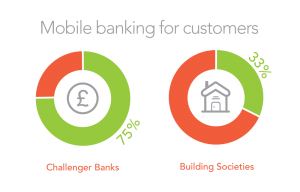
Majority of challenger banks and building societies believe they provide better service for customers though improvement is needed on mobile strategies
New research from Aspect Software launched today has found that the vast majority of challenger banks and building societies believe that they are either at least as good, or better, than the Big Four (Barclays, HSBC, Lloyds and RBS) in providing good customer service and innovating new services.
However, according to Aspect, while the data is encouraging, it suggests that more work is needed on mobile strategy if they are to disrupt the industry and win a greater share of the market.
The research, which was conducted by Vanson Bourne on behalf of Aspect, polled 100 senior decision-makers from challenger banks and building societies with an operation in the UK. The results revealed that around two thirds of respondents think that they are better at achieving consistently high customer satisfaction levels (65 per cent) and employee engagement (64 per cent) than the Big Four, while 59 per cent think that they are better at providing fast customer service. Moreover, around two fifths (43 per cent) think that they are better at developing innovative new services.
However, around half believed that they fared about the same or worse than the Big Four in their use of new technology (57 per cent) and their mobile banking strategies (56 per cent) and in their ability to price services competitively (47 per cent).

“While absolutely subjective, understanding how challenger banks and building societies view their capabilities in relation to the Big Four can give us some important insight into where they are placing their emphasis when building their businesses.
Many of these institutions were established in response to deficiencies identified in the traditional banking sector; namely, the Big Four’s inability to let customers transact with them in the ways that they want to and their historically non-customer-centric approaches.
It should come as little surprise, then, that so many challengers believe that they are better at providing good and fast customer service, engaging their employees and developing innovative, Millennial-friendly services.
“It is worth noting that the results were not universally positive and that as good as may not be ‘good enough’ to persuade banking customers to leave the Big Four,” Peter continued.
“There is a widespread inertia in the market, with many customers staying with their banks for decades according to the Competition and Markets Authority (1). This means that challengers must go over the odds to make a compelling enough case for customers to make the move. It is clear from the research that there is some work to do in that regard, most notably, on their mobile banking strategies and the adoption of new technologies, which fared the least well in our research. Considering the critical role that mobile banking and technology play – and will continue to play – in today’s financial services landscape, this is an area that these institutions will need to focus on.
“Today, the Big Four have the home advantage. Unless challenger banks and building societies can up their game when it comes to the customer experience and technology to make a strong case for customers to switch, they will retain it. While a good number have made good progress in that regard, others have a significant amount of work to do,” Peter concluded.

Peter Littlewood is a Finance Solutions Consultant at Aspect Software
To download the Intelligence Paper, The rise and rise of challenger banks, visit: Click Here
For additional information about Aspect Software visit their Website, read their Blogs or view their Company Profile


